Entry Database : PDB / ID : 4hn6Title GR DNA Binding Domain R460D/D462R - TSLP nGRE Complex DNA (5'-D(*AP*GP*CP*TP*CP*TP*CP*CP*CP*GP*GP*AP*GP*GP*CP*G)-3')DNA (5'-D(*CP*GP*CP*CP*TP*CP*CP*GP*GP*GP*AP*GP*AP*GP*CP*T)-3')Glucocorticoid receptor Keywords / / / / / / / Function / homology Function Domain/homology Component
/ / / / / / / / / / / / / / / / / / / / / / / / / / / / / / / / / / / / / / / / / / / / / / / / / / / / / / / / / / / / / / / / / / / / / / / / / / / / / / / / / / / / / / / / / / / / / / / / / / / / / / / / / / / Biological species Homo sapiens (human)synthetic construct (others) Method / / / Resolution : 2.549 Å Authors Hudson, W.H. / Youn, C.E. / Ortlund, E.A. Journal : Nat.Struct.Mol.Biol. / Year : 2013Title : The structural basis of direct glucocorticoid-mediated transrepression.Authors : Hudson, W.H. / Youn, C. / Ortlund, E.A. History Deposition Oct 18, 2012 Deposition site / Processing site Revision 1.0 Dec 12, 2012 Provider / Type Revision 1.1 Jan 2, 2013 Group Revision 1.2 Jan 16, 2013 Group Revision 1.3 Jan 24, 2018 Group / Structure summary / Category / pdbx_unobs_or_zero_occ_atoms / Item Revision 1.4 Feb 28, 2024 Group Advisory / Data collection ... Advisory / Data collection / Database references / Derived calculations Category chem_comp_atom / chem_comp_bond ... chem_comp_atom / chem_comp_bond / database_2 / pdbx_struct_conn_angle / pdbx_unobs_or_zero_occ_atoms / struct_conn / struct_ref_seq_dif / struct_site Item _database_2.pdbx_DOI / _database_2.pdbx_database_accession ... _database_2.pdbx_DOI / _database_2.pdbx_database_accession / _pdbx_struct_conn_angle.ptnr1_auth_asym_id / _pdbx_struct_conn_angle.ptnr1_auth_seq_id / _pdbx_struct_conn_angle.ptnr1_label_asym_id / _pdbx_struct_conn_angle.ptnr1_label_seq_id / _pdbx_struct_conn_angle.ptnr2_auth_asym_id / _pdbx_struct_conn_angle.ptnr2_auth_seq_id / _pdbx_struct_conn_angle.ptnr2_label_asym_id / _pdbx_struct_conn_angle.ptnr3_auth_asym_id / _pdbx_struct_conn_angle.ptnr3_auth_seq_id / _pdbx_struct_conn_angle.ptnr3_label_asym_id / _pdbx_struct_conn_angle.ptnr3_label_seq_id / _pdbx_struct_conn_angle.value / _struct_conn.pdbx_dist_value / _struct_conn.ptnr1_auth_asym_id / _struct_conn.ptnr1_auth_seq_id / _struct_conn.ptnr1_label_asym_id / _struct_conn.ptnr1_label_seq_id / _struct_conn.ptnr2_auth_asym_id / _struct_conn.ptnr2_auth_seq_id / _struct_conn.ptnr2_label_asym_id / _struct_ref_seq_dif.details / _struct_site.pdbx_auth_asym_id / _struct_site.pdbx_auth_comp_id / _struct_site.pdbx_auth_seq_id
Show all Show less
 Open data
Open data Basic information
Basic information Components
Components Keywords
Keywords Function and homology information
Function and homology information Homo sapiens (human)
Homo sapiens (human) X-RAY DIFFRACTION /
X-RAY DIFFRACTION /  SYNCHROTRON /
SYNCHROTRON /  MOLECULAR REPLACEMENT / Resolution: 2.549 Å
MOLECULAR REPLACEMENT / Resolution: 2.549 Å  Authors
Authors Citation
Citation Journal: Nat.Struct.Mol.Biol. / Year: 2013
Journal: Nat.Struct.Mol.Biol. / Year: 2013 Structure visualization
Structure visualization Molmil
Molmil Jmol/JSmol
Jmol/JSmol Downloads & links
Downloads & links Download
Download 4hn6.cif.gz
4hn6.cif.gz PDBx/mmCIF format
PDBx/mmCIF format pdb4hn6.ent.gz
pdb4hn6.ent.gz PDB format
PDB format 4hn6.json.gz
4hn6.json.gz PDBx/mmJSON format
PDBx/mmJSON format Other downloads
Other downloads 4hn6_validation.pdf.gz
4hn6_validation.pdf.gz wwPDB validaton report
wwPDB validaton report 4hn6_full_validation.pdf.gz
4hn6_full_validation.pdf.gz 4hn6_validation.xml.gz
4hn6_validation.xml.gz 4hn6_validation.cif.gz
4hn6_validation.cif.gz https://data.pdbj.org/pub/pdb/validation_reports/hn/4hn6
https://data.pdbj.org/pub/pdb/validation_reports/hn/4hn6 ftp://data.pdbj.org/pub/pdb/validation_reports/hn/4hn6
ftp://data.pdbj.org/pub/pdb/validation_reports/hn/4hn6 Links
Links Assembly
Assembly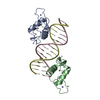
 Components
Components Homo sapiens (human) / Gene: NR3C1, GRL / Production host:
Homo sapiens (human) / Gene: NR3C1, GRL / Production host: 
 X-RAY DIFFRACTION / Number of used crystals: 1
X-RAY DIFFRACTION / Number of used crystals: 1  Sample preparation
Sample preparation SYNCHROTRON / Site:
SYNCHROTRON / Site:  APS
APS  / Beamline: 22-BM / Wavelength: 1 Å
/ Beamline: 22-BM / Wavelength: 1 Å Processing
Processing MOLECULAR REPLACEMENT / Resolution: 2.549→44.479 Å / SU ML: 0.34 / σ(F): 1.35 / Phase error: 25.78 / Stereochemistry target values: ML
MOLECULAR REPLACEMENT / Resolution: 2.549→44.479 Å / SU ML: 0.34 / σ(F): 1.35 / Phase error: 25.78 / Stereochemistry target values: ML Movie
Movie Controller
Controller




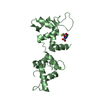
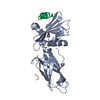
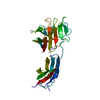
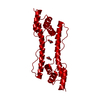
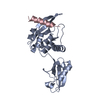
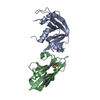

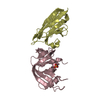
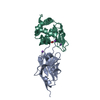
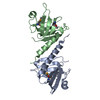
 PDBj
PDBj
















































